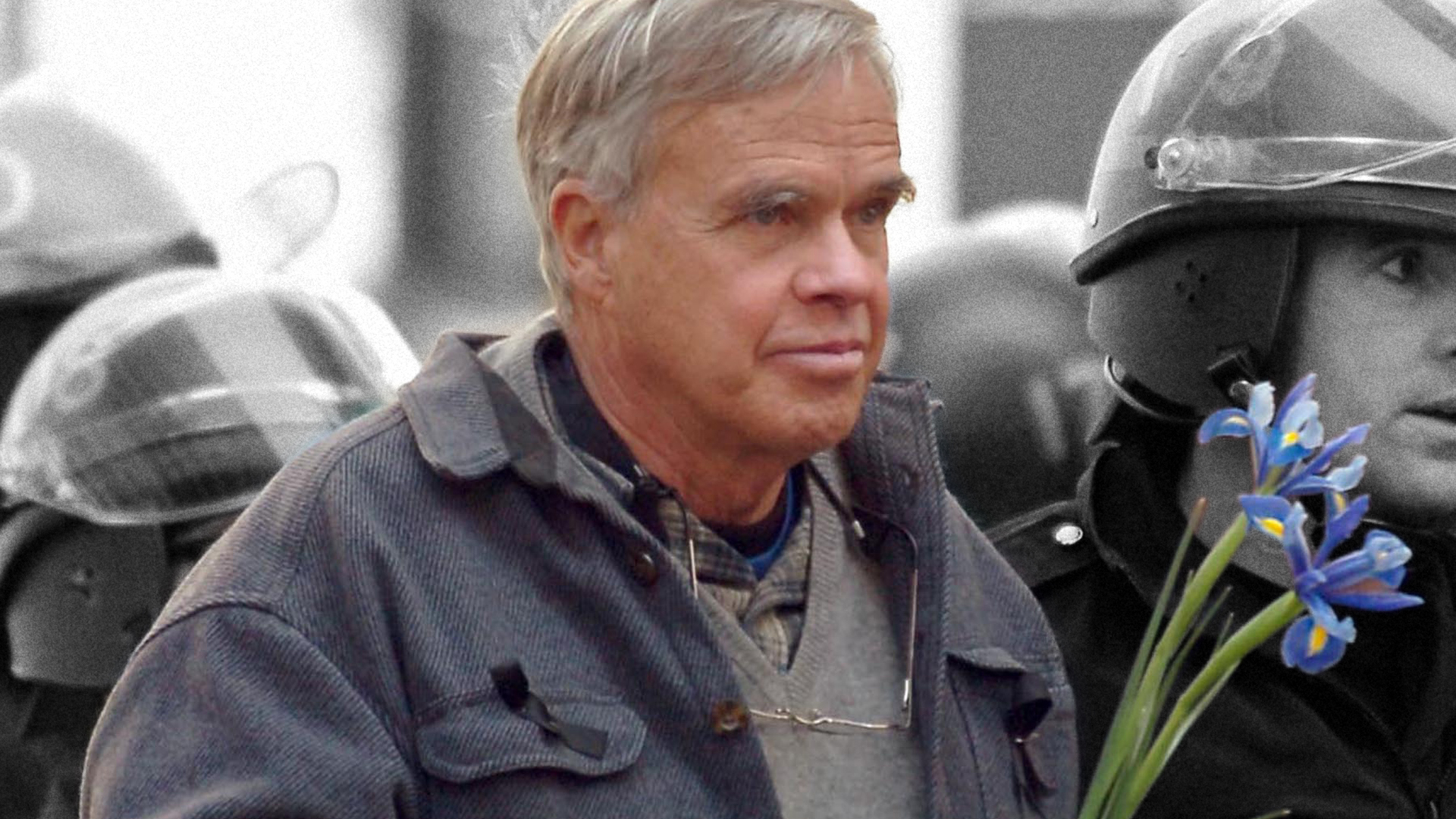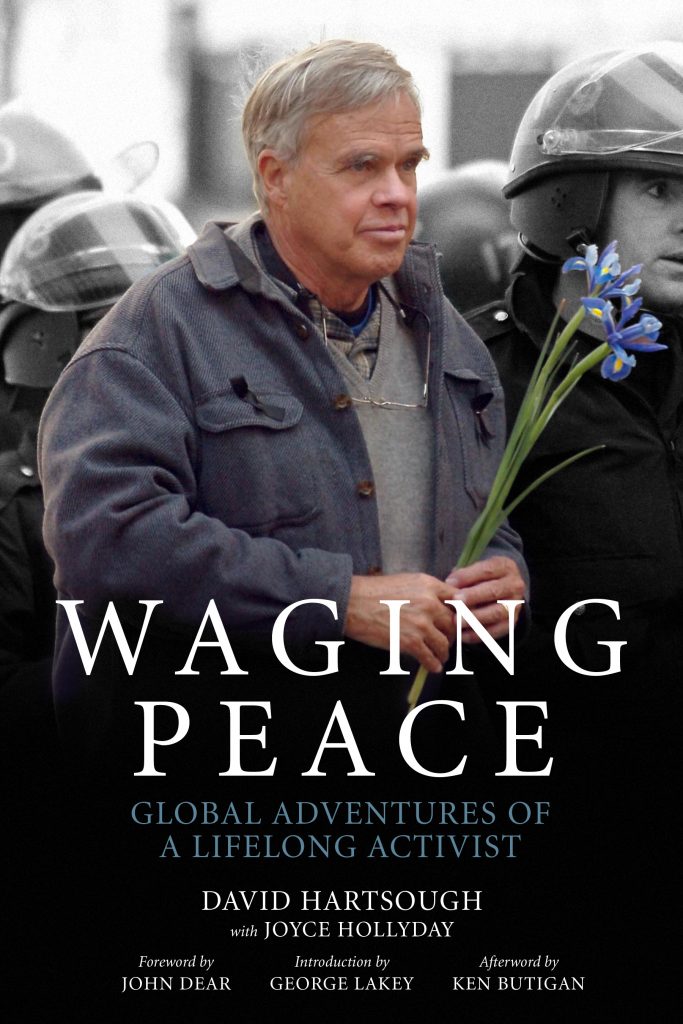An Inspiring Life’s Work Continues To Inspire
By Kevin Zeese and Margaret Flowers
Popular Resistance
November 6th, 2015
Just the other night we were discussing our upcoming November actions to stop the Trans-Pacific Partnership and other corporate trade agreements with two organizers, both in their twenties, Mackenzie McDonald Wilkins and J. Lee Stewart. We were trying to figure out what we could do to stop the corporate push for laws that will undermine workers and the environment while strengthening corporate power over democracy. This led to talking about how it is impossible to predict what the impacts of a protest action will be, even when the odds are against you.
At the same time, we both brought up David Hartsough who has been a civic activist for justice for 60 years. We started telling stories that he writes about in his memoir, Waging Peace: The Global Adventures of a Lifelong Activist. His remarkable stories show that taking brave and determined action can inspire others and even lead to transformative change.
David started his lifelong civic activism in 1956 when he was 15 years old. His father, Ray Hartsough, who was a Congregational minister involved in Quaker peace work, took him to Montgomery, AL. They arrived four months into the great civil rights bus boycott which had begun when Rosa Parks refused to move to the back of the bus.
David saw the reality of
Jim Crow segregation and the violence against African Americans,
especially directed at their churches. He could not understand how white
Christians could do this to black Christians. The experience of seeing
the boycott was life-changing, he writes:
“I was even more stunned
that the victims of the violence were persistently saying that they were
not going to give up their struggle for justice—and that they were
committed to trying to love their enemies. I was deeply moved by so many
people choosing to walk with dignity rather than ride the buses as
second-class citizens. Seeing them get up an hour early to walk to work
and get home an hour later than usual at night—refusing to hate the
people who were imposing the hated system of segregation and creating
this hardship—was profoundly inspiring and life-changing for me.”
David briefly met Rev. Dr. Martin Luther King, Jr. in Montgomery when King was only 26 years old. He notes, looking back, that there was no way of knowing at the time that King was going to become one of the most prominent figures in US history and that his strategic nonviolence would influence movements for the rest of David’s life. Indeed, during this time period King was still learning about nonviolence and how to use it to create political change.
One of the stories we told Mack and Lee was a powerful story of nonviolence. Five months after Hartsough entered Howard University, on February 1, 1960, four students from Greensboro, NC sat down at a Woolworth’s lunch counter and began the sit-in movement demanding an end to segregation at restaurants. David and fellow classmates protested in Maryland where segregation existed but then decided to go to the much more challenging state of Virginia, where in Arlington, George Lincoln Rockwell, the founder of the American Nazi Party, threatened to lynch anyone who challenged Virginia’s segregation laws.
On June 10th, David joined ten African American students from Howard and a white woman from another college in the heart of hatred and sat down at the lunch counter at the People’s Drug Store in Arlington. The owner told the police not to arrest them and closed the lunch counter. Shouts of racial hatred were heard, people threw things at them, spat on them, shoved lit cigarettes down their clothes and one threw a firecracker at them. American Nazi storm troopers showed up. They were punched and kicked to the floor. They stayed for 16 hours until the store closed for the day. Then, they came back for a second day.
On the second day, David had a life changing experience confronting the reality of nonviolent protest. Late on the second day while David was meditating on the words of the Sermon on the Mount, “Love your enemies… Do good to those who hate you,” he heard a voice behind him, “ Get out of this store in two seconds, or I’m going to stab this through your heart.” David saw a man with hatred exuding from his blazing eyes, whose jaw was quivering, and hand was shaking while holding a switchblade—about half an inch from David’s heart.
David and his colleagues had practiced how to respond to violence with nonviolence. Loving your enemy suddenly moved from theory and philosophy to a challenging reality. In brief moments David responded saying “Friend, do what you believe is right, and I will still try to love you.” The man’s jaw and hand dropped. He turned away and walked out of the store. It was a moment where David learned how love can overcome hate. David reflected on the moment and realized not only had he done the right thing, he had done the effective thing.
The students were scared and hungry; they decided to write a statement to the community urging an end to segregation. They stood at the door and read it. They concluded with a promise: “If nothing has changed in a week, we will be back.”
For six days they feared going back. Would they have the courage to face the hatred, racism and violence? They were inspired by similar actions around the country, by others facing even greater risks. They prepared to go back. On the sixth day they got a phone call telling them that the lunch counters in Arlington would be desegregated by the end of June. Faith leaders had talked to business leaders; together they reflected on the issue and decided to end segregation.
There were so many lessons for David, and now so many lessons for us. Courage, persistence, strategic nonviolence and reaching for people’s humanity all led to transformative change. We gain inspiration from each other. Courage becomes contagious and grows movements. This reality is repeated many times in David’s memoir on a variety of issues. His experiences allow us to reflect on our own actions –
strategically seeking justice can inspire changes the country and world so desperately need. We don’t know what will result, but we do know we need to fight injustice.
This is just one of many stories of David Hartsough’s long and beautiful struggle for peace and justice recounted in Waging Peace. David continues to be an inspirer in his work today. We remember him and his wife, Jan, coming to us when we were at Freedom Plaza during the Occupation of Washington, DC to talk with us about the injustices of the day and the strategy needed to transform injustice to justice. We also had David on our radio show, Clearing The FOG, where he did what he always does – without even trying – he inspired us to continue our work.
We believe David’s stories will inspire and instruct others to be advocates for justice and peace.
They prove that small actions can create great waves and move us to continue the struggle against all odds with the hope that we are bending the arc of history towards justice.
David currently serves as the executive director of Peaceworkers, based in San Francisco and is co-founder of the Nonviolent Peaceforce. He is also a co-founder of World Beyond War, seeking to create a world where war is no more.







